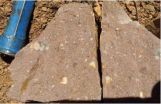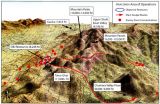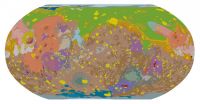(Press-News.org) Boulder, Colo., USA - An astonishing new rock formation has been revealed in the Colorado Rockies, and it exists in a deeply perplexing relationship with older rocks. Named the Tava sandstone, this sedimentary rock forms intrusions within the ancient granites and gneisses that form the backbone of the Front Range. The relationship is fascinating because it is backward: ordinarily, it is igneous rocks such as granite that would that intrude into sedimentary rocks.
According to authors Christine Smith Siddoway and George E. Gehrels, to find sandstone injected into granite is utterly uncommon -- the extensive system that is found in Colorado may be unique in the world. There is evidence that the process of formation involved very large earthquakes, or possibly another type of catastrophic event, causing liquefaction of sediment, what they call "'natural fracking' in a certain sense!" Equally astonishing is the time of formation of the Tava sandstone, determined from detrital zircon analysis: the Tava proves to be from a time period ~750 million years ago, which was not known to be represented in the Colorado Rockies: the Cryogenian Period.
FEATURED ARTICLE
Basement-hosted sandstone injectites of Colorado: A vestige of the Neoproterozoic revealed through detrital zircon provenance analysis
Christine Smith Siddoway, Dept. of Geology, The Colorado College, Colorado Springs, Colorado 80903, USA; and George E. Gehrels, Dept. of Geosciences, University of Arizona, Tucson, Arizona 85712, USA. Published online ahead of print on 22 Aug. 2014; http://dx.doi.org/10.1130/L369.1.
Other recently posted LITHOSPHERE articles are listed below.
Abstracts are online at http://lithosphere.gsapubs.org/content/early/recent. Representatives of the media may obtain complimentary copies of LITHOSPHERE articles by contacting Kea Giles at the address above.
Please discuss articles of interest with the authors before publishing stories on their work, and please make reference to LITHOSPHERE in articles published. Contact Kea Giles for additional information or assistance.
Non-media requests for articles may be directed to GSA Sales and Service, gsaservice@geosociety.org.
Metamorphism and geochronology of the exhumed Himalayan mid-crust Likhu Khola region, east-central Nepal: Recognition of a tectonometamorphic discontinuity
Richard From, Dept. of Geological Sciences, University of Saskatchewan, 114 Science Place, Saskatoon, SK, S7N 5E2, Canada, Present Address: Dept. of Geological Sciences, University of Manitoba, 125 Dysart Road, Winnipeg, MB, R3T 2N2, Canada. Published online ahead of print on 27 Aug. 2014; http://dx.doi.org/10.1130/L365.1.
This study outlines the first temperature, pressure, and time constraints for rocks in the Likhu Khola region of east central Nepal. Monazite dates outline a history of metamorphism and partial melting spanning ca. 27 to 15 Ma. An abrupt break in metamorphic pressure estimates helps define a cryptic tectonometamorphic discontinuity within the exhumed Himalayan mid-crust that is interpreted to separate rocks above and below that record different tectonometamorphic histories. This discontinuity, which can be traced laterally into the adjacent valley system to the west, is one of a growing number of such structures recently identified along the orogen. The widespread recognition of these structures indicates that not only are they regionally extensive, but also that they played a significant role in the evolution of the Himalayan orogen.
Detrital zircons from Cretaceous midcontinent strata reveal an Appalachian Mountains-Cordilleran foreland basin connection
Emily S. Finzel, Earth and Environmental Sciences Dept., University of Iowa, Iowa City, Iowa 52242, USA. Published online ahead of print on 27 Aug. 2014; http://dx.doi.org/10.1130/L367.1.
In this manuscript, Emily S. Finzel presents new detrital zircon U-Pb geochronologic data from Cretaceous strata exposed in western Iowa and eastern Nebraska provide evidence for westward-flowing river systems that stretched >2000 km from the Appalachian highlands to the western United States approximately 100 million years ago. Widespread deposition of the Dakota Formation in the midcontinent is interpreted in this study as the sedimentary record of a mantle plume beneath the Appalachians that drove uplift and erosion of the inactive mountain belt.
Petrology and geochemistry of the Valle de Santiago lower-crust xenoliths: Young tectonothermal processes beneath the central Trans-Mexican volcanic belt
Fernando Ortega-Gutiérrez et al., Instituto de Geología, Universidad Nacional Autónoma de México, Avenida Universidad 3000, México D.F., 04510, México. Published online ahead of print on 27 Aug. 2014; http://dx.doi.org/10.1130/L317.1.
The Quaternary Valle de Santiago volcanic field represents the only known place along the Trans-Mexican Volcanic Belt where abundant and large granulite-facies xenoliths from the lower continental crust have been discovered. Combined petrologic and geochemical arguments suggest that granulite facies metamorphism is coeval and genetically related to juvenile alkaline basaltic magmatism in the region, and reveal the existence of a very high-temperature gabbroic plumbing system at nearly 35 km depth. Scarce charnockitic xenoliths from the wall or roof rocks of the granulitized gabbros, lifted together by the carrier alkaline basalts, yielded latest Cretaceous to Paleocene U-Pb zircon ages, probably indicating the absence of pre-Mesozoic continental crust beneath the western sector of the Mexican arc.
Local isobaric heating above an extensional detachment in the middle crust of a Variscan allochthonous terrane (Órdenes Complex, NW Spain)
Antonio M. Álvarez-Valero et al., Departamento de Geología, Universidad de Salamanca, 37008 Salamanca, Spain. Published online ahead of print on 2 Sept. 2014; http://dx.doi.org/10.1130/L369.1.
Rocks in nature coming from high depths within the crust are exceptional witnesses of what processes are occurring in the Earth's interior. Antonio M. Álvarez-Valero and colleagues present a special example of high temperature rocks (that even underwent partial melting), at the NW Iberian Variscan belt (NW Spain), where many new theories have been advanced for the first time. These rocks from the deep crust within a particular detachment structure describe during their ascent a picture in the Earth's surface that needs an interdisciplinary study in detail of rocks and structures. Thereby, this paper focuses in the information given by the detachment rocks and how they transferred heat from the bottom to the top materials surrounding them.
Multisystem dating of modern river detritus from Tajikistan and China: Implications for crustal evolution and exhumation of the Pamir
Barbara Carrapa et al., Dept. of Geosciences, University of Arizona, Tucson, Arizona 85721, USA. Published online ahead of print on 22 Aug. 2014; http://dx.doi.org/10.1130/L360.1.
This paper by Barbara Carrapa and colleagues presents the first orogen-scale geochemical dataset for the Pamir able to constrain the crustal evolution and exhumation history of this part of the Himalaya-Tibet-Pamir orogenic system. We present new zircon U-Pb and Hf determinations, apatite fission track and white mica 40Ar/39Ar thermochronological ages from sand grains collected from rivers that drain roughly 90% of the Pamir. U-Pb ages are able to test existing terrane correlation; our new thermochronological ages show that the Pamir Mountains have experienced widespread deep Miocene erosion and that this erosion has preferentially attacked the western flank of the range, which is exposed to relatively intense precipitation from westerly sources. We suggest that uplift and orographic barrier in the Miocene has facilitated exhumation of the Pamir domes. Lithospheric scale processes such as southward rollback of India under Asia can explain the observed trends of southward younging ages.
Pre- to post-Cordilleran transposition history of Joss Mountain: Insights into the exhumation of the Shuswap complex, southeastern Canadian Cordillera
Davide Zanoni et al., Dipartimento di Scienze della Terra "A. Desio," Università degli Studi di Milano, Via Mangiagalli 34, 20133 Milano, Italy. Published online ahead of print on 2 Sept. 2014; http://dx.doi.org/10.1130/L346.1.
This paper by Davide Zanoni and colleagues presents the first multiscale structural analysis and P-T-d-t evolution history of the polydeformed rocks of the Joss Mountain domain of the Shuswap complex in the southeastern Canadian Cordillera (British Columbia). We applied an analytical method, commonly used in the European Alps to define tectono-metamorphic units, based on the integration of multiscale structural analysis and mineral chemical and radiometric age data. This work contributes to the knowledge of the intra-lithospheric trajectories of tectonic units within the North American Cordillera and gives new insights into the pre-Cordilleran and syn-Cordilleran paleo-tectonic setting of this part of the Shuswap complex.
http://www.geosociety.org/
INFORMATION:
Contact: Kea Giles
+1-303-357-1057
kgiles@geosociety.org
Researchers reveal new rock formation in Colorado
New Lithosphere articles posted online
2014-09-23
ELSE PRESS RELEASES FROM THIS DATE:
Note to young men: Fat doesn't pay
2014-09-23
Men who are already obese as teenagers could grow up to earn up to 18 percent less than their peers of normal weight. So says Petter Lundborg of Lund University, Paul Nystedt of Jönköping University and Dan-olof Rooth of Linneas University and Lund University, all in Sweden. The team compared extensive information from Sweden, the United Kingdom and the United States, and the results are published in Springer's journal Demography.
The researchers analyzed large-scale data of 145,193 Swedish-born brothers who enlisted in the Swedish National Service for mandatory military ...
Immune system is key ally in cyberwar against cancer
2014-09-23
Research by Rice University scientists who are fighting a cyberwar against cancer finds that the immune system may be a clinician's most powerful ally.
"Recent research has found that cancer is already adept at using cyberwarfare against the immune system, and we studied the interplay between cancer and the immune system to see how we might turn the tables on cancer," said Rice University's Eshel Ben-Jacob, co-author of a new study this week in the Early Edition of the Proceedings of the National Academy of Sciences.
Ben-Jacob and colleagues at Rice's Center for Theoretical ...
UTSA microbiologists discover regulatory thermometer that controls cholera
2014-09-23
Karl Klose, professor of biology and a researcher in UTSA's South Texas Center for Emerging Infectious Diseases, has teamed up with researchers at Ruhr University in Bochum, Germany to understand how humans get infected with cholera, Their findings were released this week in an article published by the Proceedings of the National Academy of Sciences.
Cholera is an acute infection caused by ingestion of food or water that is contaminated with the bacterium Vibrio cholerae. An estimated three to five million cases are reported annually and 100,000-120,000 people die from ...
'Space bubbles' may have aided enemy in fatal Afghan battle
2014-09-23
WASHINGTON, DC—In the early morning hours of March 4, 2002, military officers in Bagram, Afghanistan desperately radioed a Chinook helicopter headed for the snowcapped peak of Takur Ghar. On board were 21 men, deployed to rescue a team of Navy SEALS pinned down on the ridge dividing the Upper and Lower Shahikot valley. The message was urgent: Do not land on the peak. The mountaintop was under enemy control.
The rescue team never got the message. Just after daybreak, the Chinook crash-landed on the peak under heavy enemy fire and three men were killed in the ensuing firefight.
A ...
This week from AGU: New geologic map of Mars, storm surge in Florida
2014-09-23
From this week's Eos: The New Geologic Map of Mars: Guiding Research and Education
Currently, five spacecraft are investigating Mars, and a swarm of new missions to the Red Planet either have been launched or are in development. They are designed to probe the surface, subsurface, and atmosphere with a host of scientific instruments. Where will they make new discoveries? Clues to where they should focus investigations can be gleaned from the planet's new geologic map.
From AGU's journals: History of storm surge in Florida strongly underestimated
The observational ...
Water-quality trading can reduce river pollution
2014-09-23
DURHAM, N.C. -- Allowing polluters to buy, sell or trade water-quality credits could significantly reduce pollution in river basins and estuaries faster and at lower cost than requiring the facilities to meet compliance costs on their own, a new Duke University-led study finds.
The scale and type of the trading programs, though critical, may matter less than just getting them started.
"Our analysis shows that water-quality trading of any kind can significantly lower the costs of achieving Clean Water Act goals," said Martin W. Doyle, professor of river science and policy ...
State policies are effective in reducing power plant emissions, CU-led study finds
2014-09-23
A new study led by the University of Colorado Boulder found that different strategies used by states to reduce power plant emissions -- direct ones such as emission caps and indirect ones like encouraging renewable energy -- are both effective. The study is the first analysis of its kind.
The findings are important because the success of the Environmental Protection Agency's proposed Clean Power Plan depends on the effectiveness of states' policies in reducing power plants' carbon dioxide emissions. The plan would require each state to cut CO2 pollution from power plants ...
Big changes in the Sargasso Sea
2014-09-23
Over one thousand miles wide and three thousand miles long, the Sargasso Sea occupies almost two thirds of the North Atlantic Ocean. Within the sea, circling ocean currents accumulate mats of Sargassum seaweed that shelter a surprising variety of fishes, snails, crabs, and other small animals. A recent paper by MBARI researcher Crissy Huffard and others shows that in 2011 and 2012 this animal community was much less diverse than it was in the early 1970s, when the last detailed studies were completed in this region.
This study was based on field research led by MBARI ...
Study finds gallbladder surgery can wait
2014-09-23
LOS ANGELES – (September 23, 2014) –Laparoscopic cholecystectomy, a minimally invasive procedure to remove the gallbladder, is one of the most common abdominal surgeries in the U.S. Yet medical centers around the country vary in their approaches to the procedure with some moving patients quickly into surgery while others wait.
In a study published online Monday in the American Journal of Surgery, researchers found gallbladder removal surgery can wait until regular working hours rather than rushing the patients into the operating room at night.
"The urgency of removing ...
'Bendy' LEDs
2014-09-23
VIDEO:
This is an animation of the micro-rod growth process.
Click here for more information.
WASHINGTON D.C., Sept. 23, 2014 -- "Bendy" light-emitting diode (LED) displays and solar cells crafted with inorganic compound semiconductor micro-rods are moving one step closer to reality, thanks to graphene and the work of a team of researchers in Korea.
Currently, most flexible electronics and optoelectronics devices are fabricated using organic materials. But inorganic compound ...
LAST 30 PRESS RELEASES:
Air pollution exposure and birth weight
Obstructive sleep apnea risk and mental health conditions among older adults
How talking slows eye movements behind the wheel
The Ceramic Society of Japan’s Oxoate Ceramics Research Association launches new international book project
Heart-brain connection: international study reveals the role of the vagus nerve in keeping the heart young
Researchers identify Rb1 as a predictive biomarker for a new therapeutic strategy in some breast cancers
Survey reveals ethical gaps slowing AI adoption in pediatric surgery
Stimulant ADHD medications work differently than thought
AI overestimates how smart people are, according to HSE economists
HSE researchers create genome-wide map of quadruplexes
Scientists boost cell "powerhouses" to burn more calories
Automatic label checking: The missing step in making reliable medical AI
Low daily alcohol intake linked to 50% heightened mouth cancer risk in India
American Meteorological Society announces Rick Spinrad as 2026 President-Elect
Biomass-based carbon capture spotlighted in newly released global climate webinar recording
Illuminating invisible nano pollutants: advanced bioimaging tracks the full journey of emerging nanoscale contaminants in living systems
How does age affect recovery from spinal cord injury?
Novel AI tool offers prognosis for patients with head and neck cancer
Fathers’ microplastic exposure tied to their children’s metabolic problems
Research validates laboratory model for studying high-grade serous ovarian cancer
SIR 2026 delivers transformative breakthroughs in minimally invasive medicine to improve patient care
Stem Cell Reports most downloaded papers of 2025 highlight the breadth and impact of stem cell research
Oxford-led study estimates NHS spends around 3% of its primary and secondary care budget on the health impacts of heat and cold in England
A researcher’s long quest leads to a smart composite breakthrough
Urban wild bees act as “microbial sensors” of city health.
New study finds where you live affects recovery after a hip fracture
Forecasting the impact of fully automated vehicle adoption on US road traffic injuries
Alcohol-related hospitalizations from 2016 to 2022
Semaglutide and hospitalizations in patients with obesity and established cardiovascular disease
Researchers ‘listen in’ to embryo-mother interactions during implantation using a culture system replicating the womb lining
[Press-News.org] Researchers reveal new rock formation in ColoradoNew Lithosphere articles posted online







